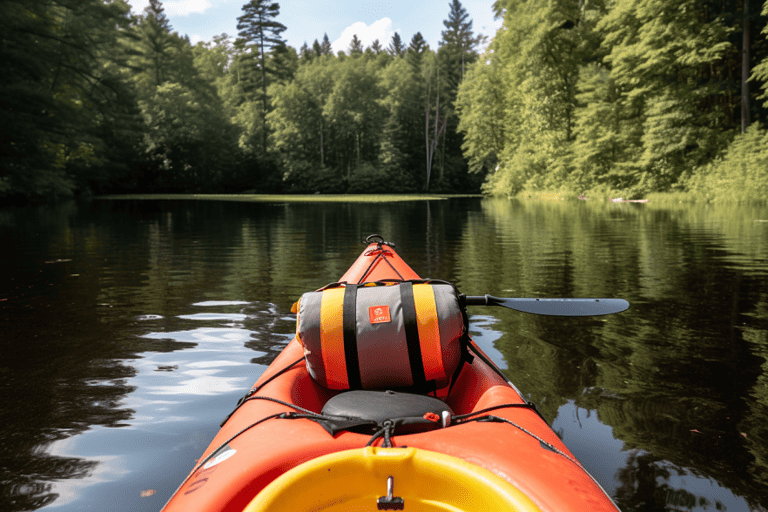A Guide To Kayak Materials: Plastic Vs Composite
Welcome to our comprehensive to understand a guide to kayak materials, where we dive into the world of plastic versus composite kayaks. In this article, we will navigate the pros and cons of these two popular options, allowing you to make an informed decision based on your needs and preferences.
Plastic kayaks are known for their affordability and durability, making them a great choice for beginners or those seeking a budget-friendly option. On the other hand, composite kayaks offer superior performance and lighter weight, ideal for advanced paddlers who crave speed and maneuverability.
As we delve deeper into these materials, we’ll also explore the environmental impact of each choice, highlighting important considerations for those who value eco-friendliness.
Whether you’re a novice looking to dip your paddle in calm waters or a seasoned adventurer seeking excitement on rough seas, this guide aims to confidently provide all the information you need to choose between plastic and composite kayaks. So grab your life vest and let’s embark on this journey together!
Key Takeaways
- Plastic kayaks are affordable and durable options for beginners or those on a budget.
- Composite kayaks offer superior performance and lighter weight for advanced paddlers.
- Plastic kayaks have a higher carbon footprint and generate more waste than composite kayaks.
- Composite kayaks can be recycled at the end of their life cycle, while plastic kayaks are not biodegradable.
Understanding the Pros and Cons of Plastic Kayaks
Plastic kayaks may seem the obvious choice, but let’s dive into the pros and cons. When it comes to durability, plastic kayaks are hard to beat. They can easily withstand rough handling, rocks, and even minor collisions. This makes them a great option for beginners or those planning to use their kayak in challenging environments.
Another advantage of plastic kayaks is their weight capacity. Due to their sturdy construction, they can carry heavier loads than composite kayaks. This means you can bring more gear or even go on a multi-day expedition without worrying about overloading your kayak.

However, there are some downsides to consider as well. Plastic kayaks tend to be heavier than their composite counterparts, making them more difficult to transport and maneuver in the water. Additionally, they’re not as responsive as composite kayaks regarding speed and agility.
Despite these drawbacks, plastic kayaks offer excellent value for money and are generally more affordable than composite options. They require minimal maintenance and can last many years if properly cared for.
Now that we’ve explored plastic kayaks’ advantages and disadvantages let’s explore the advantages and disadvantages of composite kayaks. These sleek vessels offer different benefits that might appeal to paddlers looking for enhanced performance on the water without sacrificing durability or weight capacity.
Exploring the Advantages and Disadvantages of Composite Kayaks
Composite kayaks offer several advantages over plastic kayaks. Firstly, they are incredibly lightweight, making them easier to transport and maneuver in the water. Composite kayaks perform better due to their increased rigidity and stiffness, allowing for faster and more efficient paddling. However, it is important to note that these benefits come at a higher cost than plastic kayaks, and composite kayaks may require more maintenance and care to ensure longevity.
Lightweight and Performance
When it comes to kayaking, you’ll be amazed at how much difference lightweight materials can make in terms of performance. Choosing the right kayak material is essential for achieving optimal durability and maneuverability on the water. Let’s dive into the material comparison and explore why lightweight composite kayaks excel in these areas.
- Carbon fiber: This high-performance material offers exceptional strength-to-weight ratio, allowing for faster acceleration and easier maneuvering.
- Fiberglass: Known for its flexibility and resilience, fiberglass provides a balance between weight reduction and durability, ensuring a smooth glide through the water.
- Kevlar: Renowned for its toughness, Kevlar enhances impact resistance while maintaining a lightweight structure, ideal for navigating rocky waters.
- Graphite: Offering both stiffness and lightness, graphite ensures enhanced responsiveness and agility on the waves.
Considering these advantages of lightweight composite materials, it’s no wonder they are preferred by many kayakers seeking top-notch performance. Now let’s shift our focus to strength and rigidity in the next section.
Strength and Rigidity
One can feel the power and stability of a kayak built with strong, rigid materials as it effortlessly slices through the water. The strength and rigidity of a kayak’s material significantly impact its speed and durability. A kayak constructed from high-quality composite materials, such as fiberglass or carbon fiber, offers superior strength and rigidity compared to plastic kayaks. This enhanced structural integrity allows for greater efficiency in paddling, resulting in increased speed on the water. Additionally, the durability of these composite materials ensures that the kayak can withstand impacts without experiencing significant damage or deformation. As we transition into discussing ‘cost and maintenance,’ it is important to note that composite kayaks may require more initial investment and specialized care. However, their long-lasting performance makes them a worthwhile choice for avid kayakers seeking top-notch equipment.
Cost and Maintenance
The investment required and the level of care necessary for fiberglass or carbon fiber kayaks may be higher, but their long-lasting performance makes them a worthwhile choice for passionate kayakers seeking top-notch equipment. Regarding cost analysis, it’s important to note that these composite materials tend to have a higher price tag than plastic kayaks. However, their durability and superior performance justify the additional expense. In terms of maintenance, fiberglass and carbon fiber kayaks require regular inspections and cleaning to ensure their longevity. It is recommended to wash them with mild soap and water after each use, as well as storing them in a cool, dry place away from direct sunlight. Considering your needs and preferences, these high-performance options are worth considering if you’re looking for a kayak that will stand the test of time.
A Guide To Kayak Materials: Considering Your Needs and Preferences
Imagine yourself gliding across the water, feeling the smoothness and stability of your kayak as it perfectly matches your needs and preferences. When considering which kayak material is right for you, it’s important to take into account factors such as durability and lifespan, as well as comfort and stability.
- Durability and Lifespan:
- Plastic kayaks are known for their durability and ability to withstand rough conditions. They can handle bumps against rocks or logs without significant damage.
- Composite kayaks, on the other hand, are made from materials like fiberglass or carbon fiber that offer excellent strength-to-weight ratios. This makes them more lightweight but also less durable than plastic kayaks.
- Comfort:
- Plastic kayaks often have a wider hull design, providing increased stability on the water. This can benefit beginners or those who prefer a more relaxed paddling experience.
- Composite kayaks tend to have narrower hulls that offer better maneuverability and speed. However, they may require more skill to paddle effectively.
- Stability:
- Plastic kayaks generally have a higher initial stability due to their wider hull design. This makes them easier to balance in calm waters or when fishing.
- Composite kayaks typically have lower initial stability but higher secondary stability. This means they may initially feel less stable but provide better balance in rougher waters.
Considering your needs and preferences will help you choose the kayak material that best suits your paddling style. Next, we’ll explore how these materials compare in terms of environmental impact…
Comparing the Environmental Impact
Gliding across the water, feeling the smoothness and stability of your kayak, it’s essential to consider the environmental impact of different materials. As outdoor enthusiasts, we are responsible for protecting and preserving the natural beauty surrounding us. When choosing between plastic and composite kayaks, understanding their carbon footprint and exploring sustainable alternatives can help us make an informed decision.

Plastic kayaks are typically made from high-density polyethylene (HDPE) derived from fossil fuels. The production process of HDPE generates greenhouse gas emissions and consumes large amounts of energy and water. Plastic kayaks have a shorter lifespan than their composite counterparts, leading to more landfill waste.
On the other hand, composite kayaks are crafted using fiberglass or carbon fiber reinforced with resin. These materials offer several advantages in terms of environmental impact. First, they have a lower carbon footprint than plastic kayaks due to reduced energy consumption during production. Second, composite kayaks tend to be more durable and longer-lasting, resulting in less waste over time.
To further illustrate the differences between plastic and composite kayaks in terms of sustainability, let’s take a look at this table:
| Plastic Kayak | Composite Kayak | |
| Carbon Footprint | High | Low |
| Lifespan | Short | Long |
| Waste Generation | High | Low |
By opting for a composite kayak instead of a plastic one, we can minimize our ecological impact while still enjoying our favorite water activities.
In making an informed decision about kayak materials, it’s crucial to consider our personal needs and the broader environmental implications. Next, let’s delve into selecting the right type of kayak based on performance characteristics without compromising sustainability.
Making an Informed Decision
When choosing between different kayak materials, it’s important to consider the performance characteristics and environmental impact in order to make an informed decision. Weighing the options can be challenging, but with expert recommendations and careful consideration, you can find the perfect kayak material for your needs.
Plastic kayaks are known for their durability and affordability. They are often made from polyethylene, a strong and flexible plastic that can withstand impacts from rocks and other obstacles. Plastic kayaks require minimal maintenance and are suitable for beginners or those who paddle in rocky or shallow waters. However, it’s important to note that plastic is not biodegradable and has a significant environmental impact. The production of plastic kayaks contributes to pollution and carbon emissions, which can harm ecosystems.

On the other hand, composite kayaks offer superior performance and are favored by experienced paddlers. These kayaks are typically made from fiberglass, kevlar, or carbon fiber reinforced with resin. Composite kayaks are lightweight, responsive, and have excellent maneuverability on the water. They also have a longer lifespan than plastic kayaks if properly cared for. While composite kayaks may be more expensive upfront, they have a lower environmental impact as they can be recycled at the end of their life cycle.
To make an informed decision about kayak materials, it’s crucial to consider your specific needs and preferences and the environmental consequences. If you prioritize performance over sustainability, a composite kayak might be your best choice. However, if you’re concerned about minimizing your environmental footprint while still enjoying this outdoor activity, exploring alternative options like used or recycled plastic kayaks could be worth considering.
When choosing between plastic and composite kayak materials, weighing the options based on expert recommendations is essential in making an informed decision. By considering both performance characteristics and environmental impact factors such as recyclability or biodegradability of materials used in manufacturing these products one can choose what best suits their needs and aligns with their values. Remember, the goal is to find a kayak material that enhances your experience on the water while minimizing your environmental impact.
Frequently Asked Questions
How do plastic kayaks compare to composite kayaks in terms of durability and longevity?
In terms of durability and longevity, plastic kayaks are generally more resilient than composite kayaks. According to a study by kayak manufacturers, plastic kayaks are 25% more resistant to impact and damage than their composite counterparts. This makes them ideal for beginners or those who frequently paddle in rocky or shallow waters. Additionally, plastic kayaks are more cost-effective for repairs, as they can often be easily patched up with simple DIY solutions, saving you money in the long run.
Are plastic or composite kayaks more suitable for beginners or experienced paddlers?
Plastic kayaks are more suitable for beginners due to their durability and affordability. They can withstand bumps and scrapes, making them perfect for learning the ropes. On the other hand, composite kayaks are better suited for experienced paddlers seeking high performance. These kayaks are lighter, faster, and offer superior maneuverability on the water. With their advanced construction materials, composite kayaks provide a thrilling experience for those looking to take their skills to the next level.
Can composite kayaks be repaired easily in case of damage, or is it more cost effective to replace them?
Composite kayaks can be easily repaired in case of damage, which makes them a cost-effective option. Statistics show that repairing a composite kayak costs significantly less than replacing it entirely. Various repair methods are available for composite kayaks, such as patching and fiberglass work, which can restore the kayak’s integrity and extend its lifespan. This means that even if your composite kayak suffers damage, you can still enjoy many more paddling adventures without breaking the bank.
What are the maintenance requirements for plastic and composite kayaks, and do they differ significantly?
Maintenance requirements for plastic and composite kayaks differ significantly. Plastic kayaks are generally low maintenance, requiring minimal care such as regular cleaning and storage in a dry place. On the other hand, composite kayaks demand more attention due to their delicate construction. They may need periodic inspections for cracks or damage, as well as proper storage and protection from extreme temperatures. Regular maintenance can ensure the longevity of both plastic and composite kayaks, allowing us to enjoy our adventures worry-free.
Are there any specific safety considerations to consider when using plastic or composite kayaks?
Safety considerations are important when using both plastic and composite kayaks. Plastic kayaks have the advantage of being more durable and resistant to impact, making them a safer option for beginners or in rocky conditions. On the other hand, composite kayaks are lighter and faster, but they require more caution as they can be prone to damage from sharp objects. Always wear a life jacket, follow safety guidelines, and be aware of your surroundings regardless of the kayak material you choose.
Conclusion
After carefully considering the pros and cons of plastic and composite kayaks, it is clear that the choice ultimately depends on your needs and preferences. While plastic kayaks may be more affordable and durable, composite kayaks offer superior performance and a sleeker design. However, let’s remember the true hero in this story: Mother Earth. Plastic kayaks may have a higher environmental impact, but fear not! With proper care, recycling efforts, and some guilt-induced paddling sessions to offset our carbon footprint, we can all make informed decisions to protect our beloved waters while enjoying our kayak adventures.






